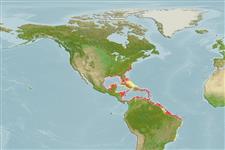Common names from other countries
Environment: milieu / climate zone / depth range / distribution range
экология
; солоноватоводный; пределы глубины 0 - 20 m (Ref. 275). Tropical; 15°C - 32°C (Ref. 275); 40°N - 38°S, 99°W - 33°W (Ref. 275)
Atlantic Ocean.
Length at first maturity / Size / Вес / Возраст
Maturity: Lm ? range ? - ? cm Max length : 8.0 cm ML самец/пол неопределен; (Ref. 275); 12 cm ML (female)
Minimum depth range from Ref. 83938. Found in inshore waters to a depth of 20 m. Can tolerate low salinities allowing it to move to estuaries during warmer temperatures. Feeds on zooplankton, small crustaceans and fishes (Ref. 843).
Life cycle and mating behavior
половая зрелость | размножение | нерест | икра | Fecundity | личинки
Members of the class Cephalopoda are gonochoric. Male and female adults usually die shortly after spawning and brooding, respectively. Mating behavior: Males perform various displays to attract potential females for copulation. During copulation, male grasp the female and inserts the hectocotylus into the female's mantle cavity where fertilization usually occurs. Life cycle: Embryos hatch into planktonic stage and live for some time before they grow larger and take up a benthic existence as adults.
Основная ссылка
ссылки | координатор | соавторы
Roper, C.F.E., M.J. Sweeney and C.E. Nauen. 1984. (Ref. 275)
Статус Красного Списка МСОП (Ref. 130435)
Статус СИТЕС (Ref. 108899)
Not Evaluated
Not Evaluated
Использование человеком
рыболовство: коммерческий; наживка: occasionally
| FishSource |
инструменты
дополнительная информация
ресурсы в Интернет
Estimates based on models
Preferred temperature
(Ref.
115969): 23.4 - 28.2, mean 27 (based on 579 cells).
Уязвимость
Low vulnerability (10 of 100).
